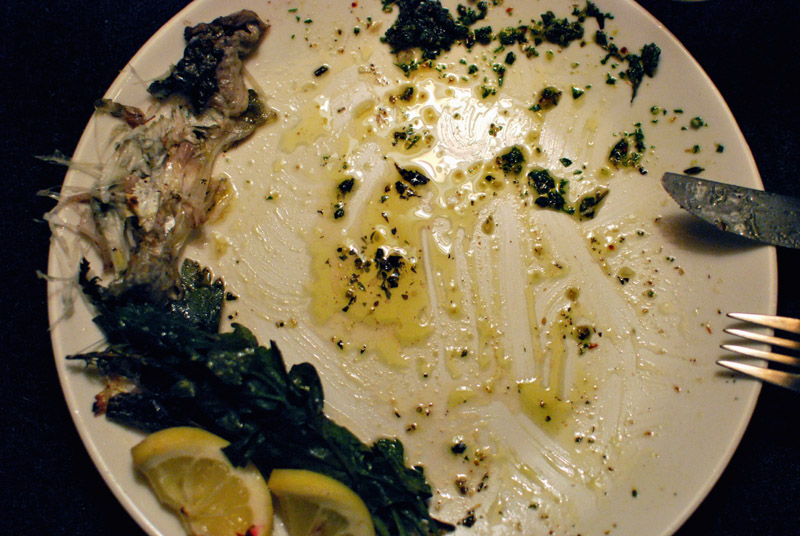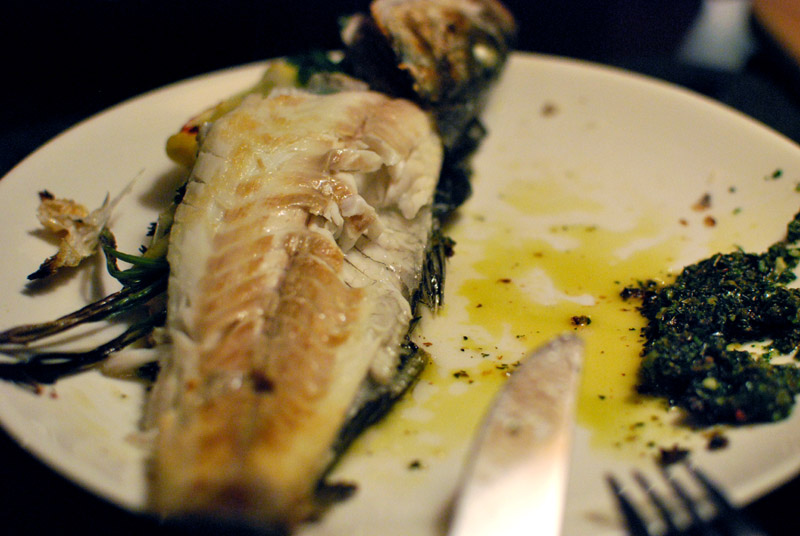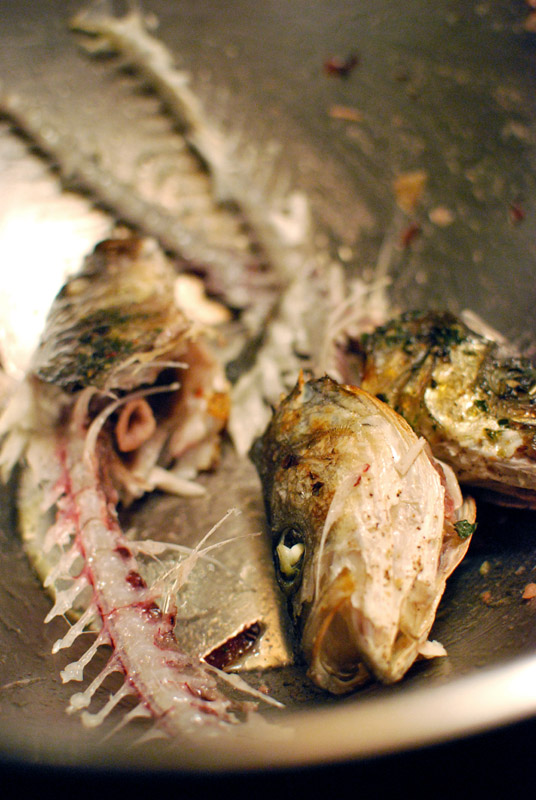Behold the whole, broiled branzini.

Behold the aftermath of the whole, broiled branzini.

Apparently, this is a perfect fish to grill or broil, as Michael Ruhlman notes in technical detail. All I knew was that I had a dinner guest, seafood was in order, and at the store were the prettiest whole fish sitting out on ice, all clear eyes and red gills. Parsley and lemon followed them into the cart, as always happens when I buy seafood.
At home, browsing through my newest cookbook, I happened upon an almost-too-simple recipe for something called Oreganato Sauce. It only caught my eye because it was shown pairing with fish, but I decided to make it because I had all the ingredients on hand, and I had to put something on the table sooner or later. Because I’m a contrarian, I had to use my newly-acquired Korean chili flakes, instead of the crushed red pepper flakes called for in the recipe.
The oreganato sauce practically made itself (after chopping the parsley and garlic), and rested on the counter while I busied myself with cocktail hour and conversation with good friends. We got hungry, began preparing dinner in earnest, and not twenty minutes later were rewarded with some of the best fish I’ve ever had. The silence during the meal – between usually-talkative people – proved me right.
The amazing thing about the sauce was how the character changed completely when cooked vs. when raw. Branzini is almost trout-like in flavor, and it sang underneath the bright punch of the raw oreganato sauce, just as well as it did with the earthier flavor of the sauce that had been cooked on top of it. Either way, it’s fantastic. It’s like the difference between a fresh fig and a dried one; neither is like the other, but both are wonderful.
It’s hardly a recipe, but here’s how it’s done: one whole branzino per person (head-on and gutted, please), seasoned inside with salt and pepper, stuffed with parsley, thyme, and slices of lemon, and rubbed with a spoonful or two of the oreganato sauce. Lay on a lightly-oiled sheet pan, pop under a very hot broiler, and cook until the skin begins to blister, turning once, about 4 or 5 minutes per side. Serve with more oreganato sauce on the side, and plenty of bread to dip into the oil that will collect on your plate.
Again, here is whole broiled branzini.
And here is where whole broiled branzini used to be.
Any questions?
Oreganato Sauce
Adapted from Simple Soirées, by Peggy Knickerbocker
Makes about 3/4 cup
This might seem like a bit of a throw-away recipe, but the sum of its parts is far more than the simplicity might belie. It’s so, so, so good. Use it on fish, on eggs, on quinoa or brown rice, on chicken, on goat cheese with crackers. Anything. Everything.
Though I call for Korean chili flakes, gochugaru, I know not everyone has the stuff lying around. If you don’t have it, omit it, or use instead a pinch of any ground or crushed-up dried red pepper you like. Gochugaru is less spicy than the red pepper flakes most Americans are used to, so use caution when substituting.
1/2 cup finely minced flat-leaf parsley
3 to 4 cloves garlic, minced finely
2 tablespoons dried oregano
1/2 teaspoon Korean chili flakes (gochugaru)
1/2 teaspoon kosher salt
Zest of 1 lemon, grated finely
Freshly ground black pepper, to taste
Olive oil, to taste
1. Finely chop the parsley and garlic. In a non-reactive bowl, mix with the remaining ingredients, adding olive oil until just moist, or to taste. Let stand 30 minutes at room temperature before serving.


